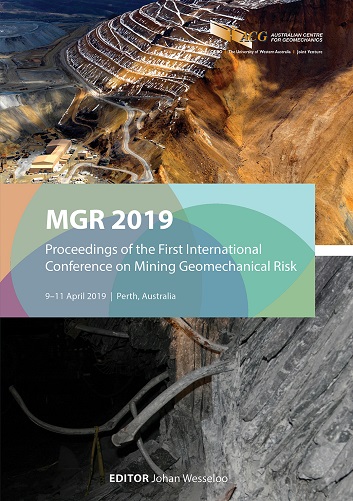Production-associated risk factors of seismicity in the Kiirunavaara mine

|
Authors: Vatcher, J; Boskovic, M; Sjoberg, J |
DOI https://doi.org/10.36487/ACG_rep/1905_14_Vatcher
Cite As:
Vatcher, J, Boskovic, M & Sjoberg, J 2019, 'Production-associated risk factors of seismicity in the Kiirunavaara mine', in J Wesseloo (ed.), MGR 2019: Proceedings of the First International Conference on Mining Geomechanical Risk, Australian Centre for Geomechanics, Perth, pp. 261-272, https://doi.org/10.36487/ACG_rep/1905_14_Vatcher
Abstract:
When it comes to deep mining, the geomechanical risks of production planning decisions are amplified due to the high-loading environment and typical deep rock mass behaviour such as seismic activity, ground falls, spalling, strainbursting, and rockbursting. Assessing how production decisions influence hazards is an important aspect of risk assessment. A preliminary analysis of the historic production at the Luossavaara-Kiirunavaara Aktiebolag (LKAB) Kiirunavaara mine indicated a significant likelihood of ore/host rock remnants after production blasting in some volumes of the mine. These remnants are caused by a combination of drill fan geometry, orebody geometry, safety regulations minimising the likelihood for drill breakthrough, and typical limitations of blasting practices. Numerical stress analysis modelling was used for a selected volume of the mine critical to production to evaluate the effect of possible geometric realisations of the production remnants. A qualitative risk assessment of the production remnants was completed, with focus on results that indicated seismically active volumes. The understanding gained from this work is important to the mine’s future production planning, as it gives insight into factors that increase the risk of seismicity.
Keywords: risk factors, production planning, numerical modelling, uncertainty
References:
Andrieux, P, Hudyma, MR, O’Connor, CP, Cotesta, L, Brummer, R, Hart, R, Detournay, C, & Nelson, M 2008, ‘Calibration of large-scale three-dimensional non-linear numerical models of underground mines using microseismic data’, Proceedings of the 1st International FLAC/DEM Symposium on Numerical Modelling, Itasca Consulting Group, Inc., Minnneapolis, pp. 343–350.
Diederichs, MS 2000, Instability of Hard Rockmasses: The Role of Tensile Damage and Relaxation, PhD thesis, University of Waterloo, Waterloo.
Itasca Consulting Group, Inc 2018, FLAC3D, computer software, Itasca Consulting Group, Inc., Minneapolis, https://www.itascacg.com/software/flac3d
Pierce, M, Cundall, P, Mas Ivars, D, Darcel, C, Young, RP, Reyes-Montes, J & Pettitt, W 2006, Mass Mining Technology Project: Six Monthly Technical Report, Caving Mechanics, Sub-Project No. 4.2: Research and Methodology Improvement, and Sub-Project 4.3, Case Study Application, ICG06-2292-1-Tasks 2-3-14, Itasca Consulting Group, Inc., Minneapolis.
Potvin, Y & Wesseloo, J 2013, ‘Improving seismic risk management in hardrock mines’, in A Malovichko & D Malovichko (eds), Proceedings of the 8th International Symposium on Rockbursts and Seismicity in Mines, Geophysical Survey of Russian Academy of Sciences, Obninsk, and Mining Institute of the Ural Branch of the Russian Academy of Sciences, Perm,
pp. 371–386.
Ryder, JA 1988, ‘Excess shear stress in the assessment of geologically hazardous situations’, Journal of The South African Institute of Mining and Metallurgy, vol. 881, pp. 27–39.
Sandström, D 2003, State of Stress at the Kiirunavaara Mine: its Significance for Rock Mechanics Analysis, licentiate thesis, Luleå University of Technology, Luleå.
Sjöberg, J, Dahnér, C & Malmgren, L 2011, ‘Forensic analysis of a rock burst event at the Kiirunavaara Mine – results and implications for the future’ in D Sainsbury, R Hart, C Detournay & M Nelson (eds), Proceedings of the 2nd International FLAC/DEM Symposium, Continuum and Distinct Element Numerical Modeling in Geomechanics, Itasca International Inc., Melbourne, pp. 67–74.
Sjöberg, J, Lundman, P, Norduland, E & Quinteiro, C 2003, ‘Stability analysis of ore passes in the Kiirunavaara Mine’, Technology Roadmap for Rock Mechanics: 10th Congress of the International Society for Rock Mechanics, South African Institute of Mining and Metallurgy, Johannesburg, pp. 1093–1098.
Sjöberg, J, Perman, F, Quinteiro, C, Malmgren, L, Dahnér-Lindkvist, C & Boskovic, M 2012, ‘Numerical analysis of alternative mining sequences to minimise potential for fault slip rockbursting’, Journal of Mining Technology, vol. 1214, pp. 226–235.
Vatcher, J 2017, Listening to the Story of the Rock Mass: The Integration of Conventional and Unconventional Data to Understand Rock Mass Behaviour at the Kiirunavaara Mine, PhD thesis, Luleå University of Technology, Luleå.
Vatcher, J, McKinnon, SD & Sjöberg , J 2016, ‘Developing 3-D mine-scale geomechanical models in complex geological environments, as applied to the Kiirunavaara Mine’, Engineering Geology, vol. 203, pp. 140–150.
© Copyright 2025, Australian Centre for Geomechanics (ACG), The University of Western Australia. All rights reserved.
View copyright/legal information
Please direct any queries or error reports to repository-acg@uwa.edu.au
View copyright/legal information
Please direct any queries or error reports to repository-acg@uwa.edu.au
